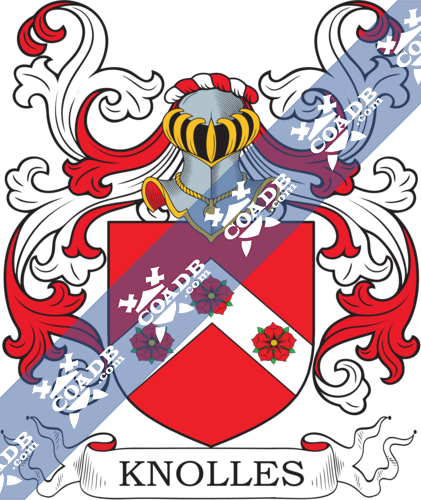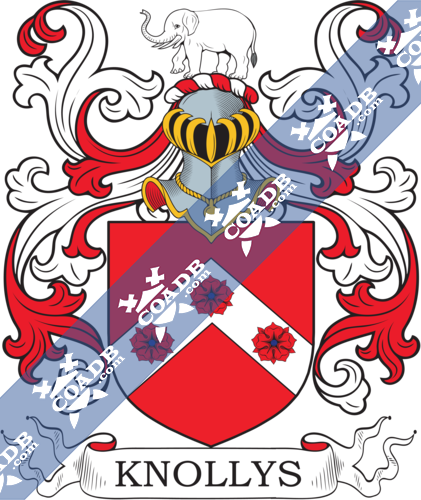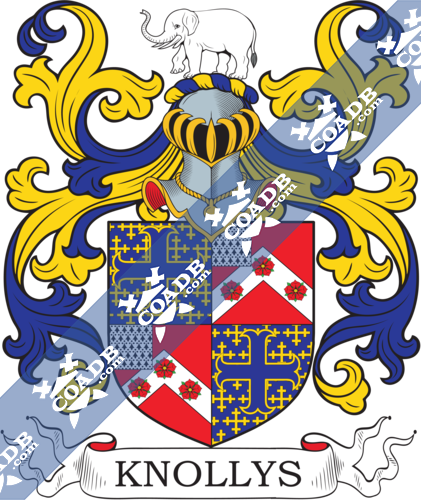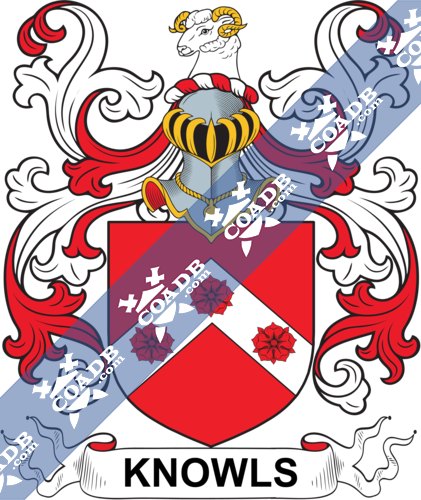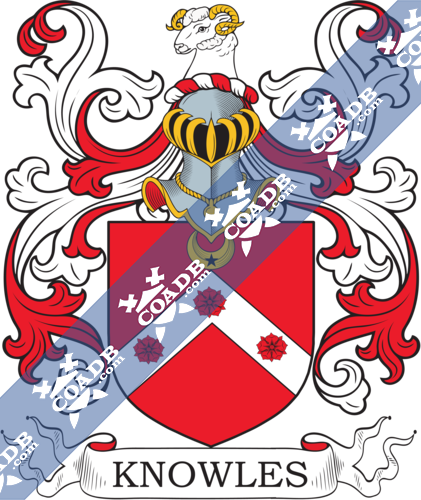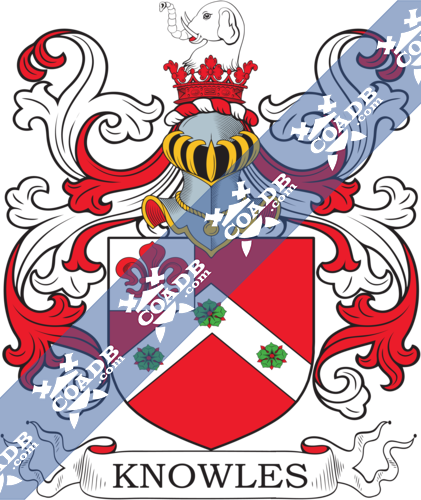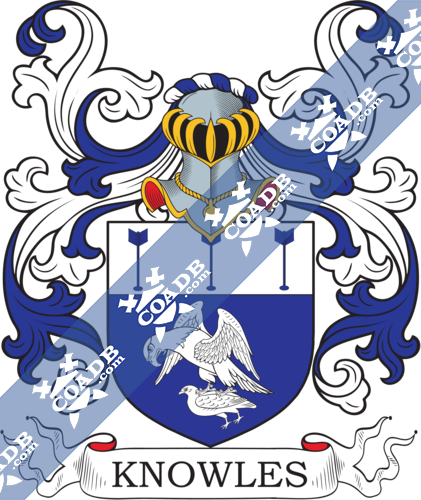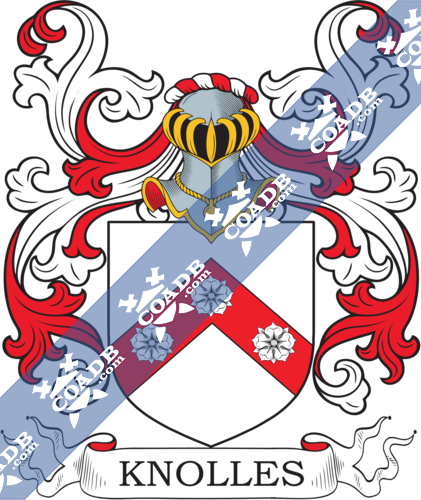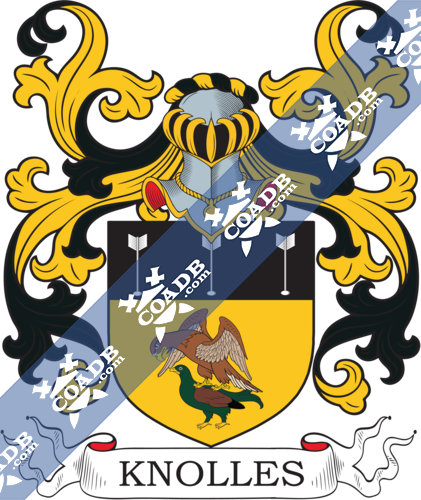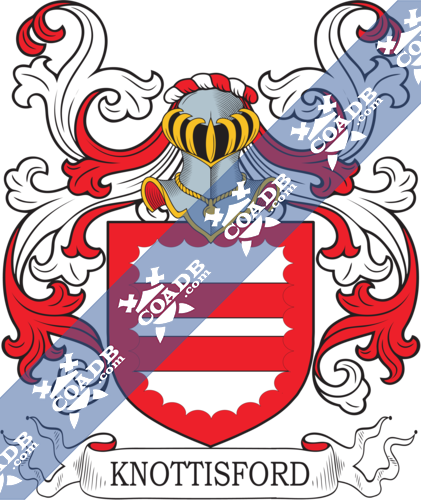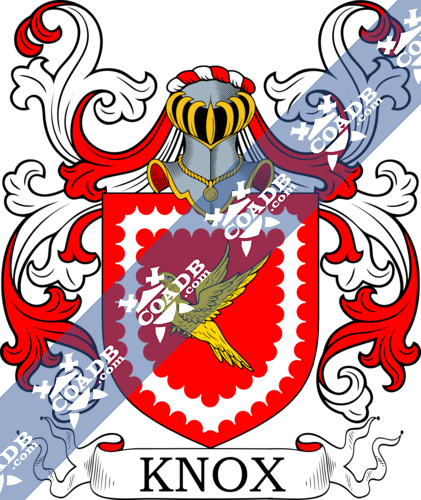Knowles Family Crest, Coat of Arms and Name History
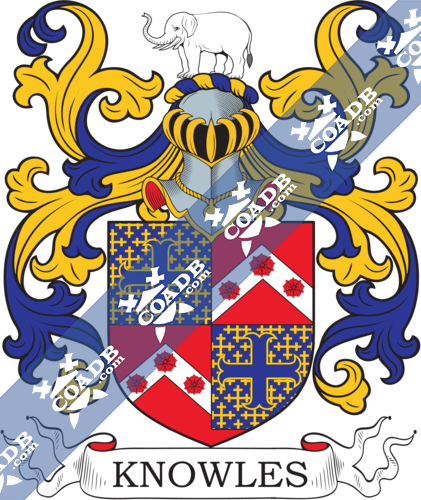
Knowles Coat of Arms Gallery
Don’t know which Coat of Arms is yours?
We can do a genealogical research. Find out the exact history of your family!
Learn MoreKnowles Origin:
England
Origins of Name:
The Knowles surname derives from old English geographical locations and was also used as a nickname. The surname originates from as far back as 7th century word ‘cnoll which means a hill top, and also used to describe a person who lived on top of a hill or near a hillock. Later, the word would become “knol” in Middle English. It is also possibly derived from the name “Cnoll”, which was a nickname used to describe someone who was stout and short.
Variations:
More common variations are: Knollys, Knoll, Knolle, Knolles, Knowles, Knowlys, Knoles
History:
England:
The first instance of Knowles in England was in ancient times, possibly before the Norman conquest, in Yorkshire where the family held a manor house. Robert de la Cnolle in 1185 in Devonshire was recorded as having the name. Thomas Knolle of Cambridgeshire in 1279, and William ate Knowle in 1296 in Sussex were also recorded as having the name.
The first known recorded spelling of the name is of Christopher Knolles in 1407 in the Freemen Register of the City of York. Gilbert de la Beri in 1202 in the Pipe Rolls of Cornwall. Roger Bury was recorded in the city of Cambridge in the Assize Register in 1260. Hubert Bery was recorded in the county of Suffolk in 1268.
Henry Knowles left for the New World from London on the ship Susan and Ellin in 1635, which set sail for the Virginia colony.
By the 17th century, the spelling ‘Knowles” was standard in England.
The most famous Knowles in England during the 19th century was Andrew Knowles. The Knowles family owned a coal mining company, Andrew Knowles and Sons that operated in Lancashire at this time, and their business dated back to the 16th century. The family would dominate coal mining until the turn of the 20th century.
The surname Knowles is the 270th most common name in Great Britain. The highest concentrations are in Leeds, Isle of Wight Lincolnshire, Cheshire, and Shropshire.
Ireland:
The Knowles surname originates from immigrants who settled in Province of Ulster in the 17th century. The Gaelic form of the name was O’Tnuthghail which was anglicized to O’Knowell and they would also anglicize their name to Newell.
United States:
Israell Knowles was the first Knowles to arrive in America and settle in Virginia in 1622. In 1635, Henry Knowles settled in Salem, Mass. One year later, Alexander Knowles would arrive in Massachusetts. 2 years later in 1638, Richard Knowles landed in Cambridge Mass.
Edmund Knowles arrived in the United States in 1699 in Deleware. He was the ancestor for many Knowles in America today. His descendants would eventually populate North Carolina and Georgia.
In the 18th Century, more Knowles would arrive in the Americas. Thomas Knowles landed in Virginia in 1701. Jane Knowles would arrive in the same year with her husband. Abner Knowles in 1782 would arrive in America.
In the 19th Century, more would emigrate from England. Luke Knowles at the age of 33 arrived in Boston, Mass. Davide Knowles would arrive in the same city 14 years later.
Caribbean
The surname Knowles was also a prominent name in the Caribbean. Damon Knowles was a farmer in Bermuda in the 1620s. James Knowles was a mixed race plantation owner on Long Island in the Bahamas in the middle of the 18th century.
Here is the population distribution of the last name Knowles:
33,000 in the United States (mainly in Florida), 18,000 in England (mainly in Lancashire), 5,000 in The Bahamas
Notable People:
Sir Robert Knowles (1325 – 1407) English leader. A prominent English knight in the Hundred Years’ War. He succeeded in overtaking two major French cities. He was known as a freebooter and a ravager due to his methods.
Sir Francis Knollys (1511) leading English courtier and statesman. He served as a courtier under Henry the VII, Edward Vi and Elizabeth I. He was a member of parliament for a number of Kings.
James Sheridan Knowles, (1784 – 1862) Irish actor and playwright. He was born in Cork, and his father was a famous lexicographer. The family moved to London, and at the young age of 14 he had already published a ballad. He would go on to earn a Medical Degree. He would later decide to give up medicine for the stage.
Andrew Knowles (1735) businessman and entrepreneur of the famous Andrew Knowles and Sons. The famous company operated in Lancashire. His father started pits in Eagly Bank.
Beyonce Knowles (1981) American singer
Blazons & Genealogy Notes
1) (Lovel Hill, co. Berks, bart.). Motto—Semper paratus. Quarterly, 1st and 4th, az. crusily of crosslets a cross moline voided or; 2nd and 3rd, gu. on a chev. ar. three roses of the first. Crest—An elephant statant ar.
3) (Samford Oreas, co. Dorset, and co. Somerset). Gu. on a bend ar. three escallops sa.
4) (Aylesham, co. Norfolk). Gu. on a chev. ar. three roses of the field, in chief a crescent or, charged with a mullet sa. Crest—A ram’s head ar. attired or.
5) (Cole Ashby, co. Northampton, and Walton, co. Suffolk; granted 1580). (Heysham Hall, co. Lancaster, and Stockwell, co. Surrey). 6) Gu. on a chev. ar. three roses vert, barbed and seeded of the field, on a canton of the second a fleur-de-lis of the first. Crest—Out of a ducal coronet gu. an elephant’s head ar.
7) Az. a hawk seizing a partridge ar. on a chief of the last three bird bolts of the first.
8) (Downton and Winchester. Visit. Hants, 1634). Or, three demi lions pass. guard. gu. Crest—A griffin segreant or.
9) (co. Chester). Ar. on a chev. gu. three roses of the field.
10) (Little Hampston, co. Devon). Or, a falcon sa. preying on a moorcock ppr. on a chief of the second three birdbolts ar.
11) Gu. on a chev. ar. three roses of the field.
12) (co. Hants). Or, three demi lions pass. guard. gu. Crest—A griffin segreant or.
13) Or, a cross couped gu. Crest—On a cloud a sphere ppr.
14) (from ped. of Sir Robert Knolles, K.G., lord of the manor of Scouthorpe, co. Norfolk, a “very valyant captayne” in the wars in France, temp. Edward III. and Richard II., who d. 17 Aug. 1407, 8 Henry IV.). Gu. on a chev. ar. three roses of the field barbed ppr.
15) (John Knolles, settled in co. Hants temp. Henry VIII.; descended of a younger branch of Sir Robert Knolles, K.G., temp. Edward III.; confirmed by St. George, Clarenceux, 1633). Same Arms, differenced with a canton erm.
16) (Grove Place, co. Hants). Gu. on a chev. ar. three roses of the field, a canton erm.
17) (Earl of Banbury, extinct; William Knollys, descended from the renowned Sir Robert Knollys, K.G., the companion in arms of the Black Prince, was created Baron Knollys 1603, Viscount Wallingford 1616, and raised to the Earldom 1626, d. 1632; Nicholas Knollys, alias Vaux, claimed the titles and scat as Earl of Banbury in the Convention Parliament, 1660, as did his descendants, until the House of Lords declared the Peerage extinct in 1813). Gu. on a chev. ar. three roses of the field. Crest—An elephant ar.
18) (Earl of Banbury, extinct; William Knollys, descended from the renowned Sir Robert Knollys, K.G., the companion in arms of the Black Prince, was created Baron Knollys 1603, Viscount Wallingford 1616, and raised to the Earldom 1626, d. 1632; Nicholas Knollys, alias Vaux, claimed the titles and scat as Earl of Banbury in the Convention Parliament, 1660, as did his descendants, until the House of Lords declared the Peerage extinct in 1813). Az. semée of crosses crosslet a cross moline or, voided throughout of the field. Crest—An elephant ar.
19) (Thame, co. Oxford, bart., extinct 1772; descended from Sir Francis Knollys, Knt., of Reading Abbey, younger brother of the Earl of Banbury). Motto—In utrumquo paratus. Same Arms, quartering gu. on a chev. ar. three roses of the field, a canton erm. Crest—An elephant ar.
20) (co. Chester, Chisping, co. Lancaster, Chipping and Harpley, co. Norfolk). Gu. on a chev. ar. three roses barbed and seeded of the field. Crest—A ram’s head ar. attired or.



